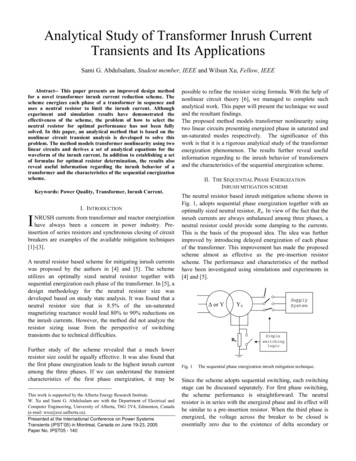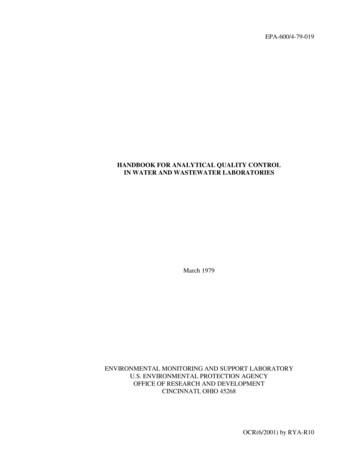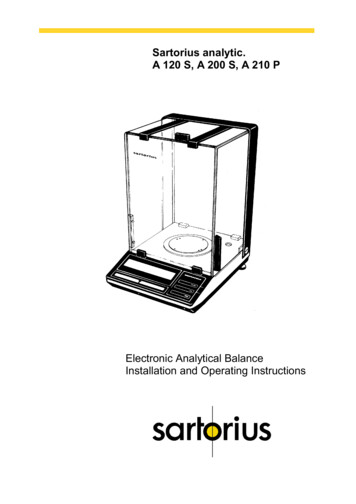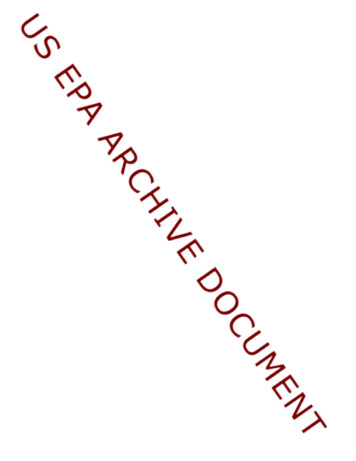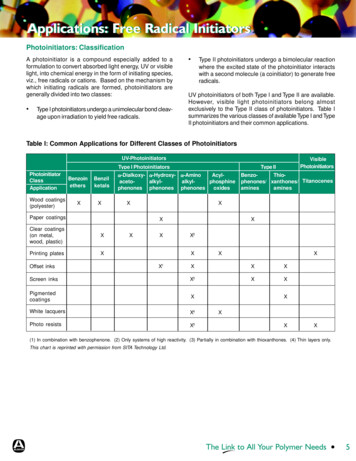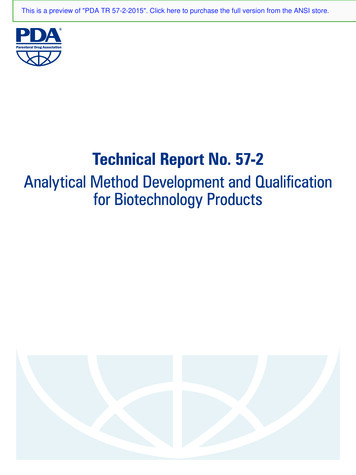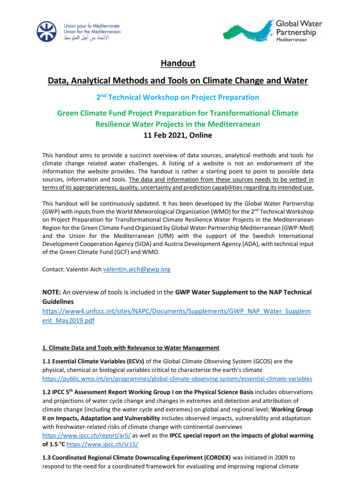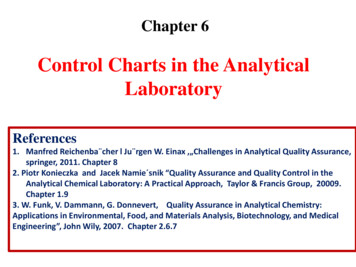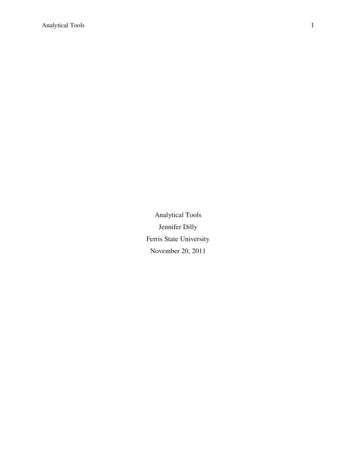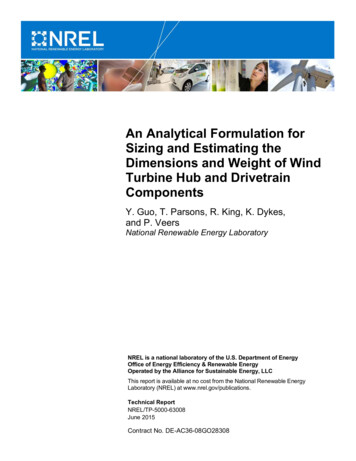
Transcription
AN ANALYTICAL STUDY OF ROBERT MUCZYNSKI’S SECOND PIANO TRIOEun Jun Oh, BM., M.M.Dissertation Prepared for the Degree ofDOCTOR OF MUSICAL ARTSUNIVERSITY OF NORTH TEXASMay 2006APPROVED:Adam Wodnicki, Major ProfessorJeffrey Snider, Minor ProfessorJoseph Banowetz, Committee MemberGraham Phipps, Director of Graduate StudiesJames C. Scott, Dean of the College of MusicSandra L. Terrell, Dean of the Robert B. ToulouseSchool of Graduate Studies
Oh, Eun Jun, An Analytical Study of Robert Muczynski’s Second Piano Trio. Doctor ofMusical Arts (Performance), May 2006, 53 pp., 31 examples, 3 tables, bibliography, 61 titles.The purpose of this study is to provide scholastic research on Robert Muczynski’sSecond Piano Trio (1975) by presenting his biographical background, discussing influences andhis musical style, and analyzing the work. Robert Muczynski (b.1929), a composer-pianist ofPolish descent, studied with Alexander Tcherepnin (1899-1977). From traditional forms andtechniques, he fashioned his own unique and innovative compositional style. The second pianotrio, in particular, was deeper and more complex in its conception and affect than previouscompositions. The first movement Andante molto opening leads to an allegro section, and thesomber second movement builds to a heavy climax. The third movement is highly rhythmic anddramatically driven.Chapter I outlines the purpose of the study and the composer’s biography. Chapter IIdescribes Muczynski’s compositional influences and the evolution of his musical language.Emphasis in this respect will be placed on the pedagogical role of Alexander Therepnin, as wellas the important connections between Prokofiev, Tcherepnin and Muczynski. An exploration ofother elements that have informed Muczynski’s style is offered. Chapter III details thecircumstances, general characteristics, and compositional technique of the Second Piano Trio.Detailed analysis of all three movements will be provided, with particular attention paid toaspects of theme, form, harmony, rhythm, meter, tempo, articulation, texture, and dynamic. Thetheoretical analysis is the main portion of this document, and after a discussion of treatment ofthe piano, concluding reflections are offered in Chapter IV.
Copyright 2006byEun Jun Ohii
TABLE OF CONTENTSPageLIST OF TABLES. ivLIST OF MUSIC EXAMPLES . vChaptersI.INTRODUCTION . 1Purpose of the Study . 1Biography of Robert Muczynski. 2II.INFLUENCES AND MUSICAL LANGUAGE . 5Influences from the Tcherepnins and Prokofiev. 5Musical Language. 6III.AN ANALYSIS OF MUCZYNSKI’S PIANO TRIO NO. 2 . 9General Information. 9The First Movement. 11Thematic Material and Form . 11Harmony . 17Rhythm, Meter, and Tempo . 22Texture and Dynamics . 25The Second Movement . 26The Third Movement . 29Form. 29Harmony . 33Rhythm, Articulation, and Meter . 39Texture and Dynamics . 43Treatment of the Piano. 46IV.CONCLUSION. 47BIBLIOGRAPHY. 49iii
LIST OF TABLESPage1.Structural Organization of the First Movement . 162.Structural Organization of the Second Movement. 263.Structural Organization of the Third Movement . 29iv
LIST OF MUSICAL EXAMPLESAll musical examples used in this dissertation are used with permission fromTheodore Presser Company.Page1.Second Piano Trio, 1st movement, mm. 1-2. 112.Second Piano Trio, 1st movement, mm. 7-8. 133.Second Piano Trio, 1st movement, mm. 42-48. 144.Second Piano Trio, 1st movement, mm. 96-100. 155-1.Second Piano Trio, 1st movement, mm. 109-110. 155-2.Second Piano Trio, 1st movement, mm. 109-110. 166-1.Second Piano Trio, 1st movement, mm. 58-62. 186-2.Second Piano Trio, 1st movement, mm. 97-100. 187-1.Second Piano Trio, 1st movement, m. 119 . 207-2.Second Piano Trio, 1st movement, m. 128 . 208.Second Piano Trio, 1st movement, mm. 129-133. 219-1.Second Piano Trio, 1st movement, m. 52 . 229-2.Second Piano Trio, 1st movement, m. 119 . 239-3.Second Piano Trio, 1st movement, m.128 . 239-4.Desperate Measures (Paganini Variations: for Piano), Op.48, mm. 19-20. 2310-1. Second Piano Trio, 1st movement, mm. 53-54. 2410-2. Second Piano Trio, 1st movement, mm. 68-69. 2410-3. Second Piano Trio, 1st movement, mm. 70-71. 2411-1. Second Piano Trio, 2nd movement, mm. 22-24 . 2711-2. Second Piano Trio, 2nd movement, mm. 27-28 . 27v
12.Second Piano Trio, 1st movement, mm. 29-32. 2713-1. Second Piano Trio, 2nd movement, mm. 31-33 . 2813-2. Second Piano Trio, 2nd movement, mm. 42-44 . 2814.Second Piano Trio, 3rd movement, mm. 1-4 . 3015.Second Piano Trio, 3rd movement, mm. 25-27 . 3016-1. Second Piano Trio, 3rd movement, mm. 25-27 . 3116-2. Second Piano Trio, 3rd movement, m. 48 . 3116-3. Second Piano Trio, 3rd movement, m. 66 . 3117-1. Second Piano Trio, 1st movement, mm. 7-8. 3217-2. Second Piano Trio, 3rd movement, mm. 100-101 . 3218-1. Second Piano Trio, 3rd movement, m.100 . 3218-2. Second Piano Trio, 3rd movement, mm. 3-4 . 3219-1. Second Piano Trio, 3rd movement, mm. 1-4 . 3419-2. Dream Cycle, Op.4, mm. 9-12. 3420-1. Second Piano Trio, 3rd movement, m. 47 . 3520-2. Second Piano Trio, 3rd movement, mm. 53-54 . 3521.Second Piano Trio, 3rd movement, mm. 25-32 . 3622.Second Piano Trio, 3rd movement, mm. 48-51 . 3623-1. Second Piano Trio, 3rd movement, mm. 66-69 . 3723-2. Second Piano Trio, 3rd movement, mm. 94-96 . 3723-3. Second Piano Trio, 3rd movement, mm. 145-146 . 3724-1. Second Piano Trio, 3rd movement, mm. 17-18 . 3724-2. Second Piano Trio, 3rd movement, mm. 25-27 . 38vi
24-3. Second Piano Trio, 3rd movement, mm. 38-41 . 3824-4. Second Piano Trio, 3rd movement, mm. 47-50 . 3825.Second Piano Trio, 3rd movement, mm. 48-49 . 3926-1. Second Piano Trio, 3rd movement, mm.145-146 . 4026-2. Second Piano Trio, 3rd movement, mm.156-158 . 4127-1. Second Piano Trio, 3rd movement, mm. 29-32 . 4227-2. Second Piano Trio, 3rd movement, mm. 38-41 . 4227-3. Second Piano Trio, 3rd movement, mm. 105-111 . 4328.Second Piano Trio, 3rd movement, mm. 133-134 . 4429.Second Piano Trio, 3rd movement, mm. 94-95 . 4430.Second Piano Trio, 3rd movement, mm. 74-75 . 4531.Second Piano Trio, 2nd movement, mm. 49-51 . 46vii
CHAPTER IINTRODUCTIONPurpose of the StudyRobert Muczynski’s compositions have become a significant part of the present-dayrepertoire; still, there is limited information available for those who wish to study and performMuczynski’s works. While his works for piano have to some degree drawn scholarly attention,his chamber works, which form an important part of his output, have been in need of researchand study.Walter Simmons states: “As musicians continue to discover, perform, and record the finemusic of Robert Muczynski, attention is directed to his three piano trios and a string trio, all ofwhich are among his strongest works. They are most-needed candidates for recording.” 1 Thepresent study thus aims to provide a thorough analysis of Robert Muczynski’s Second PianoTrio, as well as a discussion of his general musical language and compositional influences. In sodoing, the author hopes to increase awareness of the work in question, to foster positive informedreception, and to encourage performers to play and record this work.1Walter Simmons, “A Muczynski Retrospective,” Fanfare 24 (July/August 2001), 66.1
BiographyAccording to Simmons “Robert Muczynski is one of America’s most distinguishedtraditionalist composers still active today, from the generation that came of age during the yearsfollowing World War II. He is also one of the most widely performed.” 2 For the past halfcentury, Muczynski and his music have gradually drawn attention from scholars and performers,as well as listeners. His works for piano, including three sonatas and character pieces, havebecome a substantial part of recent piano literature. His unaccompanied works for soloinstruments, orchestral works, choral pieces, music for documentary film, and chamber musichave steadily gained in popularity.Of Polish descent, Muczynski was born in Chicago on March 19, in 1929. While hisfamily exhibited no musical proclivity, he nevertheless took piano lessons during his boyhood,and was an enthusiastic and talented pupil. After entering DePaul University in Chicago in1947, Muczynski began studies as a piano major with Walter Knupfer; Knupfer proved to behighly influential on the young Muczynski. In 1949, Alexander Tcherepnin, a Russian-borntheorist and composer, came to DePaul from Paris. Muczynski began studies with Tcherepnin,and his interest in composition grew instantly. Although composition would prove to be a crucialoutlet for him, he remained a piano major, and received both a Bachelor’s and Master’s Degreesin piano performance. His talents b
Muczynski has been awarded numerous international honors, such as the Concours Internationale Prize, in 1961, in Nice, France, for his Sonata for Flute and Piano, a frequently performed piece in the twentieth century flute repertoire. He was also awarded the International Society for Contemporary Music Prize for his Suite for Piano.Author: Eun Jun OhPublish Year: 2006
